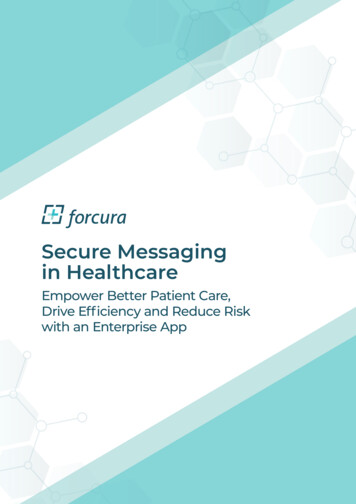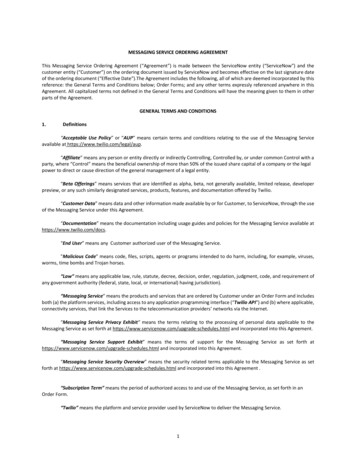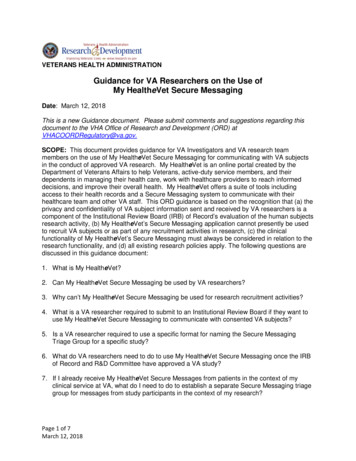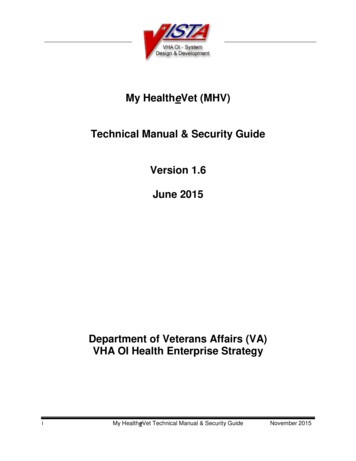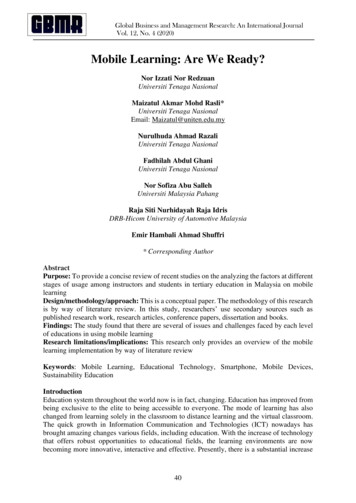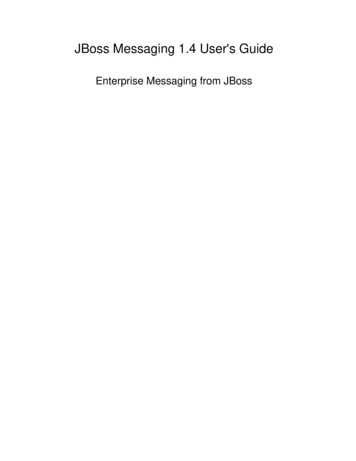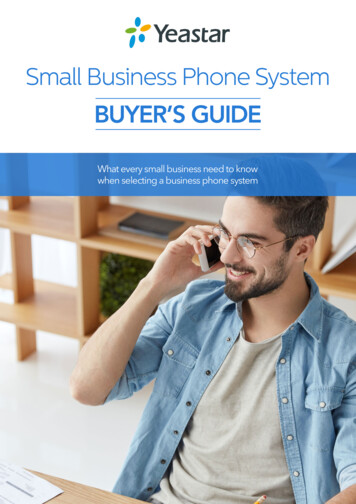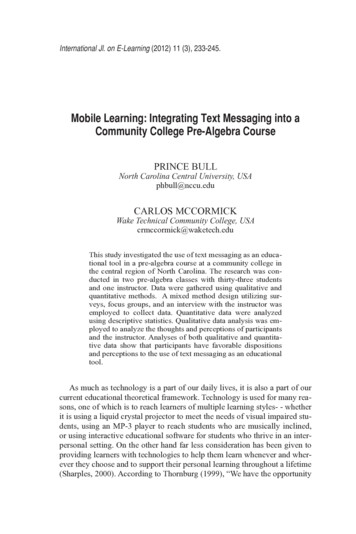
Transcription
International Jl. on E-Learning (2012) 11 (3), 233-245.Mobile Learning: Integrating Text Messaging into aCommunity College Pre-Algebra CoursePrince BullNorth Carolina Central University, USAphbull@nccu.eduCarlos McCormickWake Technical Community College, USAcrmccormick@waketech.eduThis study investigated the use of text messaging as an educational tool in a pre-algebra course at a community college inthe central region of North Carolina. The research was conducted in two pre-algebra classes with thirty-three studentsand one instructor. Data were gathered using qualitative andquantitative methods. A mixed method design utilizing surveys, focus groups, and an interview with the instructor wasemployed to collect data. Quantitative data were analyzedusing descriptive statistics. Qualitative data analysis was employed to analyze the thoughts and perceptions of participantsand the instructor. Analyses of both qualitative and quantitative data show that participants have favorable dispositionsand perceptions to the use of text messaging as an educationaltool.As much as technology is a part of our daily lives, it is also a part of ourcurrent educational theoretical framework. Technology is used for many reasons, one of which is to reach learners of multiple learning styles- - whetherit is using a liquid crystal projector to meet the needs of visual impaired students, using an MP-3 player to reach students who are musically inclined,or using interactive educational software for students who thrive in an interpersonal setting. On the other hand far less consideration has been given toproviding learners with technologies to help them learn whenever and wherever they choose and to support their personal learning throughout a lifetime(Sharples, 2000). According to Thornburg (1999), “We have the opportunity
234Bull and McCormickto use technologies in ways that support modern pedagogical thought devoted to the premise that all are capable of learning, even if the pathwaysfor each learner are different.”Mobile LearningAccording to the Horizon Report (2009), there are six areas of emergingtechnologies that will significantly impact education in the next five years-cloud computing, the use of Geocoded data, personal web tools, semanticaware applications, smart objects that give ordinary objects the power torecognize their physical location and respond appropriately, and mobile devices. This study focuses on the last of these emerging technologies, mobiledevices. One mobile device that could possibly have a big impact in education is the cell phone. This study focused on the impact of using text messaging as an educational tool in a pre-algebra class at a community college.The cell phone is a tool instructors and students are starting to use to extendteaching and learning beyond the walls of the traditional classroom. The cellphone is currently being used in a variety of ways; students are able to takequizzes via the cell phone; students can communicate with instructors andpeers, check their daily class schedule, register for classes, conduct Internetsearches, engage in social networking, and even check on the dining hallmenu (Kharif, 2008). According to William Rankin (2008), co-director ofmobile learning research at Abilene Christian University, “This is a newplatform for learning, in the same way a laptop or a desktop was a new platform.”When mobile devices are used in education they fall within the categoryof M-Learning. What is M-Learning? Mcconatha and Praul (2008) definemobile learning as learning accomplished with the use of small, portablecomputing devices. Lee and Chan (2007) define it as “the acquisition of anyknowledge and skill through using mobile technology, anywhere, anytime.”O’Malley defines M-Learning as any learning that happens when the learneris not at a fixed, predetermined location via mobile technology. While thedefinitions from these authors do not provide a concrete definition, they allagreed that M-Learning is learning via a mobile device. John Traxler (2007)states that there are some people who view mobile learning as mobility oflearning in terms of the learner’s experiences of learning with mobile devices. Traxler also believes that mobile learning will support a wide variety ofconceptions of teaching uniquely placed to support learning that is personalized, authentic, and situated. In their study of using mobile devices, Chanand Lee identified seven key attributes of mobile learning: spontaneity, personalization, informality, context-sensitivity, portability, ubiquity, and pervasiveness. Instructional technologists, instructors, and administrators aretrying to find effective ways to integrate mobile learning in traditional andonline settings. Despite not having one concise definition or a theoretical
Mobile Learning: Integrating Text Messaging into a Community College235framework, M-Learning has the potential to have a big impact in education.According to the Benefits & Compensation Digest (2008), there is a goodpossibility that M-Learning will permeate our lives in the future to meet theincreasing demand for quality, flexibility training, and to fulfill the needs oflifelong learning.As M-Learning grows, cell phones and one of their prominent features- text messaging, also known as Short Message Service (SMS)-- will paya significant role in this new learning phenomenon addressed in this study.Cell phones are particularly popular with teenagers and college students.In Varda’s (2004) article, Rebecca Noah, an AT&T wireless spokeswoman,states, “Students are most interested in using cell phones because of theirflexibility.” Ball State Media Relations Director Marc Ransford states that“text messaging has overtaken e-mail and instant messaging as the mainform of communication, as 94 percent of students send and receive textmessages.” Like cell phones the use of text messaging is relatively new interms of its use in education. Despite being a new tool in education, institutions, administration, staff, and faculty are experimenting with text messaging in a variety of ways. In a study done by Cavus and Ibrahim (2007),text messaging was used to help students learn new English words. Usingspecial software on the instructor’s computer, a new word was sent out tostudents every half an hour via text messages in order to help students become familiar with new English words. The experiment received favorablemarks from participants. Participants expressed their satisfaction and enjoyment of learning away from the classroom. Students in the Cavus and Ibrahim study recommended that other instructors should also use mobile phonebased teaching to support their teaching activities in the classroom.With any new integration, there are positives and negatives. As textmessaging, cell phones, and M-Learning move through their initial stagesof pedagogical development, issues need to be addressed. One of the big issues with text messaging is dealing with its own lingo (e.g., “your” “spelled“UR,” problems cut down to “Probs.”) For some educators this presentsa problem. Labrow (2004) expressed his concerns on this issue, “Timeschange, and letter writing isn’t the formal thing that it was. But these lowstandards of communication now pervade our everyday lives”. As for theuse of cell phones in education, Noble (2009), president of the CanadianTeachers’ Federation, does not object to the use of cell phones in education,but he has some concerns about its negative effects on teaching and learning, stating: “We have serious concerns about their misuses (e.g., cheatingon exams, cyber bullying or just being disruptive in class.” With some of thepositives and the negatives of using text messaging in education outlined,there is the need to validate its pedagogical and technological integration ineducation. Labrow sums up this view when he states that, “mobile Learning
236Bull and McCormickcould be great -- but let’s get it right, and let’s not be seduced by the speedand availability of mobile media.”Theoretical FrameworkAccording to Traxler (2007), mobile learning is essentially personal, contextual and situated; this means it is “noisy.” Being “noisy” is a possiblereason why at the time of this study M-learning does not have a concretedefinition or a simple theoretical framework as it relates to education. Thestudy is guided by the learning theory of informal and lifelong learning(Muyinda, 2007). According to Muyinda, “the learning theory of informaland lifelong learning promotes activities that support learning outside of adedicated learning environment.” Mobile technologies can support informal learning that can be intentional or accidental (Sharples, 2000). The useof mobile learning, especially text messaging via the cell phone, could beused to informally address problem-based learning. Mobile learning willhelp people blend formal and informal learning and manage their studiesacross life and career transitions (Peng, Su, Chou & Tsai, 2009). On theother hand Naismith, et al. (2004) define informal and lifelong learning asactivities that support learning outside a dedicated learning environment andformal curriculum.Importance of the StudyThis research seeks to discover the effectiveness of text messaging as ateaching tool in a pre-algebra course. Second, the research seeks to gain anunderstanding of students’ perceptions of text messaging as an educationaltool. Text messaging, a form of mobile learning, is relatively new whenit comes to education. Finally, the research seeks to build upon previousresearch to define the role of mobile technologies like cell phones, smartphones and PDA’s in education. Is mobile learning just a fad or is it something that can be an effective teaching tool for every student? This researchprovides insight into this question.Research QuestionsAs stated earlier, the purpose of this study was to investigate the impactof using text messaging as an educational tool in a pre-algebra class at acommunity college in the central region of North Carolina. This study seeksto prove that the integration of text messaging in the pre-algebra course willpositively impact the perceptions of students to the use of text messaging inthe pre-algebra course.This research seeks to reject the hypothesis that students did not have amore positive disposition to text messaging as an instructional tool after the
Mobile Learning: Integrating Text Messaging into a Community College237integration in the pre-algebra course. This research was guided by the following research questions:1. How effective was text messaging as an instructional tool in a prealgebra course?2. What are students’ perceptions to text messaging as an educationaltool?3. In what ways can text messaging be used to enhance the educational experience?4. To what extent can text messaging be utilized to support communication, reflection, and interest, and thus provide pedagogically rich learning environments that engage and motivate the learner?ParticipantsThe research was conducted in two pre-algebra classes at a communitycollege located in the central region of North Carolina. Thirty-three studentsand one instructor volunteered to participate in the study.Research DesignThe study conducted in spring 2010, utilized both qualitative and quantitative design methodologies. Participants completed a pre-survey at the beginning of the course and a post-survey at the end of the course. (See Table1.) They also participated in a focus group session at the end of the treatment. The purpose of the focus group was to collect and analyze informationon the perceptions of participants on the use of text messaging and cellulartelephones in their pre-algebra course. The recorded session was transcribedand analyzed. The data were analyzed using triangulation to identify patterns and common themes. The following are examples of questions posedduring the focus group discussion:1. What are some of your thoughts about having text messages sent toyou as part of your pre-algebra course?2. How did the text messages enhance your participation in class?3. What types of text messages did you like the most during this experience?4. What are your views on using text messaging in education?The course instructor provided the text messages researchers sent out tostudents. The normal routine for the instructor was to provide the text messages to the researchers at the beginning of the week. Researchers wouldcheck daily with the instructor to see if there were any last minute text messages the instructor would like to send out that were not given to the researcher at the beginning of the week. Generally, the instructor provided
Bull and McCormick238four text messages to send out during the week. However, there were severalweeks students received a text message everyday, (Monday – Friday). Researchers sent out text messages at various times of the day, mainly betweenthe hours of 10 a.m. - 8 p.m., Monday - Sunday via a smart phone (AppleiPhone). Each text was archived for the purpose of discussing the text message at the end of the experiment with the focus group and the instructorand to group them into categories. (See Table 2.) For the purposes of thisresearch, the text message delivery was a one-way communication from instructor to students. This was done to maintain privacy for the instructor,reduce contact hours with students, and prevent constant engagement.Table 1Pre and Post-Survey Text Messaging and Cell PhoneEducational Uses InstrumentsInstructions: Place an ‘x’ between each adjective pair to indicatehow you feel about text messaging in your pre-algebra course.To me, text messaging in education ns nothingunappealingmundaneworthlessuninvolvingnot neededimportantinterestingrelevantexcitingmeans a ructions: Place an ‘x’ between each adjective pair to indicatehow you feel about cell phone use in your pre-algebra course.To me, cell phone use in education elevantrelevantunexcitingexcitingmeans nothingmeans a valuableuninvolvinginvolvingnot neededneeded
Mobile Learning: Integrating Text Messaging into a Community College239The surveys were used to understand the participants’ perceptions of textmessaging in a pre-algebra classroom. The survey allowed participants torank both text messaging and cell phone in 10 categories; Important, Interesting, Relevant, Exciting, Means a lot, Appealing, Fascinating, Valuable,Involving, and Needed on a 7 point scale. The participants ranked each category from 1-7 with one being the lowest and seven being the highest. Themean was compared on a 70 point scale. A gain of 5 points from the pretestto the posttest would be deemed as statistically significant in this study.The instrument was developed by researchers. Using SPSS (now IBMPASW) the Cronbach alpha reliability test was done on the instrument. Thereliability of the instrument was determined at .973. Cronbach’s alpha reliability coefficient normally ranges between 0 and 1. However, there is actually no lower limit to the coefficient. The closer Cronbach’s alpha coefficient is to 1.0 the greater the internal consistency of the items in the scale.It should also be noted that an alpha of .8 is a reasonable goal. It should alsobe noted that while a high value for Cronbach’s alpha indicates good internal consistency of the items in the scale, it does not mean that the scale isone-dimensional.Conclusions and FindingsQualitative FindingsThe results acquired from this study clearly provide evidence that textmessaging is a viable tool that can enhance the teaching and learning experiences of students. The qualitative analysis yielded several themes from thestudy. Students liked the fact that they can get reminders, practice problems,and updates right on their mobile devices. No longer did they have to waitin long lines to use a computer at the school lab or worry about finding a hotspot so they could log onto their e-mail accounts. They were excited aboutthe opportunity of receiving text messages. When asked during the focusgroup session how often they would like to get educational text messages,one student said, “Bring it on! I would like to get a text everyday.” TextMessaging is a way of life for a lot of people. One participant commented,“I’d rather text than talk to people on the phone.” If texting is that importantto students and is something that they feel is not an invasion of their privacy, which was the common response from all students who participated, itis important that this piece of technology is investigated by the faculty, staffand administrators at the high school and college level. Text messaging hasthe potential to revolutionize teaching and learning mathematics and learning in general. Imagine students entering a mathematics class and believingmathematics could be fun and exciting. Text messaging could possibly provide this experience. Below are qualitative analyses to specific questions.
240Bull and McCormickHow effective was text messaging as a tool in the Pre-Algebra course?Participants stated that text messaging is an effective way to remindstudents about quizzes, labs, and other related mathematics assignments.As Vanessa puts it, “It was helpful as far as remembering if I had a test orquiz the next day. With me working, I would tend to forget and every time Iwould get off work, I would see I had a text message. So, it helped me prepare for class.” Some participants felt content related text messages helpedthem with their assignments. As Josh puts it, “the problems helped jog mymemory and kept me thinking what was going on that day. I never solvedthe problem, but if I got a text and it was a decimal problem, I was likeokay that’s what we studied today.” Fatima stated that mnemonics sent outvia text messaging made a difference: “The sayings were good because theyhelped remind me how to set up formulas when solving a problem.”What are your perceptions of integrating text messaging in your mathclass?For the majority of the participants receiving text messages was nothingnew. However, this was the first time for all students to receive text messages in an academic setting. Participants felt it was good to get text messages,especially getting practice problems. As one student put it, “The text did notmake it more exciting or fun. It just helped a lot.”What would have made the text messaging experience more appealing toyou as a student?Participants felt that providing actual mathematical problems with corresponding formulas would have enhanced the experience. Walter stated,“I can agree with sending formulas. Some people struggle in math. If yousend problems and the formula, it takes the text a little bit further and wouldbe helpful to a lot of kids who are having a hard time.” Some participantsfelt that feedback via text messaging would have enhanced their experience.Thomas stated, “If you send a problem out and we sent it back and got itwrong, tell us to use a particular rule to solve the problem.” Others wantedmore practice problems that would help them prepare for class.
Mobile Learning: Integrating Text Messaging into a Community College241Table 2Sample Text Messages1. Math - Reminder you have a quiz tomorrow. Be sure that you can solve a percent problem byusing both an equation and a proportion.2. Math - If you would like extra help, you may stay after on Thursday in LE 14 from 2:00-4:00.Bring material to work on or questions.3. Math - A tree has an 8 ft. shadow. A man places a 10 ft. ladder from the top of the tree to theend of the shadow. How tall is the tree beside it with a 6 ft. shadow? Please show your workand turn in tomorrow for the chance to win a frosty.4. Math - Are congruent triangles similar? Hint: Think about the definition of similar triangles.5. Math - Reminder: You have a test tomorrow.6. Math - Is the following a true proportion? 5 is to 12 as 10 is to 24.7. Math - A saying we used today was “King Henry Died While Drinking Chocolate Milk.” itstands for kilo, hecto, deka, whole unit, deci, centi, milli.8. Math - Remember the Excel lab must be done using Excel. If you do not have the program athome, you can find it in the computer labs here on campus.9. Math - Now is a good time to start preparing for the final. Do you know where all of you oldtests are?10. Math - Remember that all assignments are not worth the same. Use the grade breakdownsheet to average your grades. Also the extra lab is due tomorrow.11. Solve the following problem (0.5x 7 0.2x 2.5).What are the perceptions of the course instructor to the use of textmessaging in her course?The instructor in this study felt the use of text messaging in her courseboth “helped and hurt” students in the following areas:1. It helped from the standpoint of being able to send reminders tostudent about upcoming tests, quizzes or reminded them about lab duedates.2. On the other hand, students became dependent on the text messaging and not on the traditional calendar, class information, or course delivery tools. She further stated, “I had students complain if I did not send atext to remind them that they had a test or quiz. In that way it hurts. Students became dependent on the text messages. I felt like they were notlistening to me in class. I was resending information that we have talkedabout in class, posted on Blackboard, and also displayed on the calendarI provided them each month.”3. The instructor felt that she was limited as to the types of text messages she could send. She stated, “Mathematical texts are hard to sendbecause you cannot text [use] division symbols. You cannot make fractions. There is a lot of stuff that I could not text.”
242Bull and McCormick4. The instructors felt that sending all the formulas via text messaging and promoting the use of cell phones in the classroom could promotecheating. As she put it, “I think about students who I have to take theircell phones away now because they are text messaging in class whenthey are not supposed to. I would be thinking the students may have allthe formulas on their phones, which would make me worry and be concerned about students cheating on my test.”Quantitative FindingsWhile the qualitative data did provide depth to the research with encouraging results, the quantitative data provided both limited and statisticallysignificant findings. It was clear from the data that after the integration oftext messaging, participants demonstrated a more favorable perception toward text messaging. The qualitative data yielded positive findings on theattitudes of students toward integrating text messaging as an instructionaltool. In general, the research shows that students preferred text messagingover email as a form of class communication. Therefore, participants wereresponsive to text messaging as a form of communication. Participants werealso able to separate work, social, and academic communications, and accepted text messages as an extension of their education outside the walls ofthe classroom.Descriptive statistics were used to compare the means of the pre-surveyand the post-survey. On a 70-point scale, the mean for the pre-survey fortext messaging was 52, which shows a favorable disposition toward theuse of text messaging in the algebra course. The post-survey mean was 57,which shows a significant gain of 5 point towards a more favorable disposition to the use of text messaging in their education. (See Table 3.) A gain of5 points is statistically significant in this study.From the analysis of Table 3, it is clear that participants felt that text messaging in education was “important” and “valuable” with the largest postsurvey mean gains of 7 points followed by “relevant,” “appealing,” and “involving” with post-survey mean gains of 6 points. “Needed” gained 5 pointsin the post-survey mean. With six out of ten categories gaining 5 points, itis clear participants had a positive disposition to the use of text messagingin their pre-algebra course.
Mobile Learning: Integrating Text Messaging into a Community College243Table 3Text Messaging Mean Scores for Pre-and Post-Survey on a 70 Point ScaleText nt5460Exciting5154Means a olving5359Needed5358Total- Mean5257The results for the use of cell phones were not as statistically significantas those of text messaging. (See Table 4.) This could be attributed to thefact that participants use their cell phones as an everyday tool. They did notsee it as a novel tool in their classroom. Also, the focus was not on the cellphone as the instructional tool, but on text messaging delivered via the cellphone.Table 4Cell Phone Mean Scores for Pre- and Post-Survey on a 70 Point ScaleCellular ant5558Means a olving5358Needed5860Total-Mean5657
244Bull and McCormickFor analyzing the data on cell phone use in education descriptive analysiswere used to compare the means of the pre-survey and the post-survey. Ona 70-point scale the mean for the pre-survey was 56, which shows a very favorable disposition toward the use of text messaging in their algebra course.However, the post-survey mean of 57 did not show a more positive disposition after the integration of text messaging. Though this was not statisticallysignificant, it showed a positive disposition towards using cell phone in education.ConclusionsIt is clear from the descriptive statistical analysis that there was a position shift from the pre survey mean to the post-survey mean towards a morefavorable disposition towards use of text messaging as an instructional tool.This study is unique in that there was a favorable disposition towards theuse of text messaging resulting from a one-way delivery of informationfrom the instructor to students. Imagine what the outcome would have beenif students had the opportunity to engage the instructor in a two-way textmessaging communication system. The use of text messaging in instructionhas great potential that we as educators have to tap into. As educators, weneed to explore and continue to investigate the uses of text messaging ineducation. What is unique about this technology and delivery is that moststudents have access to the technology and expertise needed to facilitate thisdelivery, which means that it should be cost effective to academic institutions to put in place. The use of text messaging as the leading form of electronic communication for college students in social networking electronicenvironments makes this mode of delivery an appealing system to students.It is incumbent upon academic institutions to explore creative ways to facilitate instructional delivery through text messaging and conduct sustainedresearch on its effectiveness in enhancing the intellectual climate of the institution. In as much as the findings from both qualitative and quantitativeanalyses in this study are very encouraging, one should be cautious in extrapolating beyond this study because of limitations. First, the sample size inthe study was small. With only 33 students participating, one could expectskewed results. Second, the study was conducted within four weeks and notthe entire semester. A lengthier study may have significant implications forintegration. Also, the text message communication was a one-way communication from the instructor to the student. Even with these limitations theresearch yielded positive results on the use of text messaging instruction.
Mobile Learning: Integrating Text Messaging into a Community College245ReferencesCavus, N. & Ibrahim, N. (2009). M-learning: An experiment in using SMS to supportlearning new English language words. British Journal of Educational Technology,40(1), 78-91.Chan, A. & Lee, M. J. (2007). Pervasive, lifestyle-integrated mobile learning for distancelearners. The Journal of Open and Distance Learning, 22(3), 201-218.Harley, D., Winn, S., Pemberton, S., & Wilcox, P. (2007). Using texting to support students’ transition to university. Innovations in Education and Teaching International,44(3), 229-241.Kharif, O. (2008). Cell phones make headway in education. Business Week, 8.Labrow, P. (2004). Why learning faster is not always better. IT Training, 1(2), 20.Johnson, L., Levine, A., & Smith, R. (2009). The 2009 Horizon Report. Austin, Texas:The New Media Consortium.Marklein, M.B. (2003, October 29) Colleges catch cell phone wave. USA TODAY, 1-3.McConatha, D. & Praul, M. (2007). Mobile learning in the classroom: An empirical assessment of a new tool for students and teachers. Paper presented at WashingtonInteractive Technologies Conference 2007, Arlington, VA. Retrieved March 6, 2010from http://www.hotlavasoftware.com/article info.php?articles id 14.Ransford, M. (2009). Survey finds smart phones transforming mobile lifestyles of college students. Retrieved September 7, 2010 from html.Muyinda, Paul B. (2007) MLearning: pedagogical, technical and organisational hypes andrealities, Campus-Wide Information Systems, 24(2), pp. 97–104.Naismith, L., Lonsdale, P., Vavoula, G. and Sharples, M. (2004), Literature Review inMobile Technologies and Learning, Report 11. A Report for Nesta FuturesLab.Peng, H., Su, Y., Chou, C., & Chin-Chung, T. (2009). Ubiquitous knowledge construction:Mobile learning re-defined and a conceptual framework. Innovations in Educationand Teaching International, 46(2), 171-183.Rankin, W. (2008), co-director of mobile learning research at Abilene Christian University.Retrieved September 7, 2010, from arples, M. (2000). The design of personal mobile technologies for lifelong learning.Computers
phbull@nccu.edu carlos MccorMick Wake Technical Community College, USA crmccormick@waketech.edu This study investigated the use of text messaging as an educa-tional tool in a pre-algebra course at a community college in the central region of north carolina. The research was con-ducted in two pre-algebra classes with thirty-three students
